Abstract
Muscarinic m1 receptors traditionally are considered to be postsynaptic to cholinergic fibers, while m2 receptors are largely presynaptic receptors associated with axons. We have examined the distribution of these receptor proteins in the monkey cerebral cortex and obtained results that are at odds with this expectation. Using immunohistochemistry with specific antibodies to recombinant m1 and m2 muscarinic receptor proteins, we have demonstrated that both m1 and m2 receptors are prominently associated with noncholinergic asymmetric synapses as well as with the symmetric synapses that characterize the cholinergic pathways in the neocortex. At asymmetric synapses, both m1 and m2 receptor immunoreactivity is observed postsynaptically within spines and dendrites; the m2 receptor is also found in presynaptic axon terminals which, in the visual cortex, resemble the parvicellular geniculocortical pathway. In addition, m2 labeling was also found in a subset of nonpyramidal neurons. These findings establish that the m2 receptor is located postsynaptically as well as presynaptically. The association of m1 and m2 receptors with asymmetric synapses in central pathways, which use excitatory amino acids as neurotransmitters, provides a morphological basis for cholinergic modulation of excitatory neurotransmission.
Full text
PDF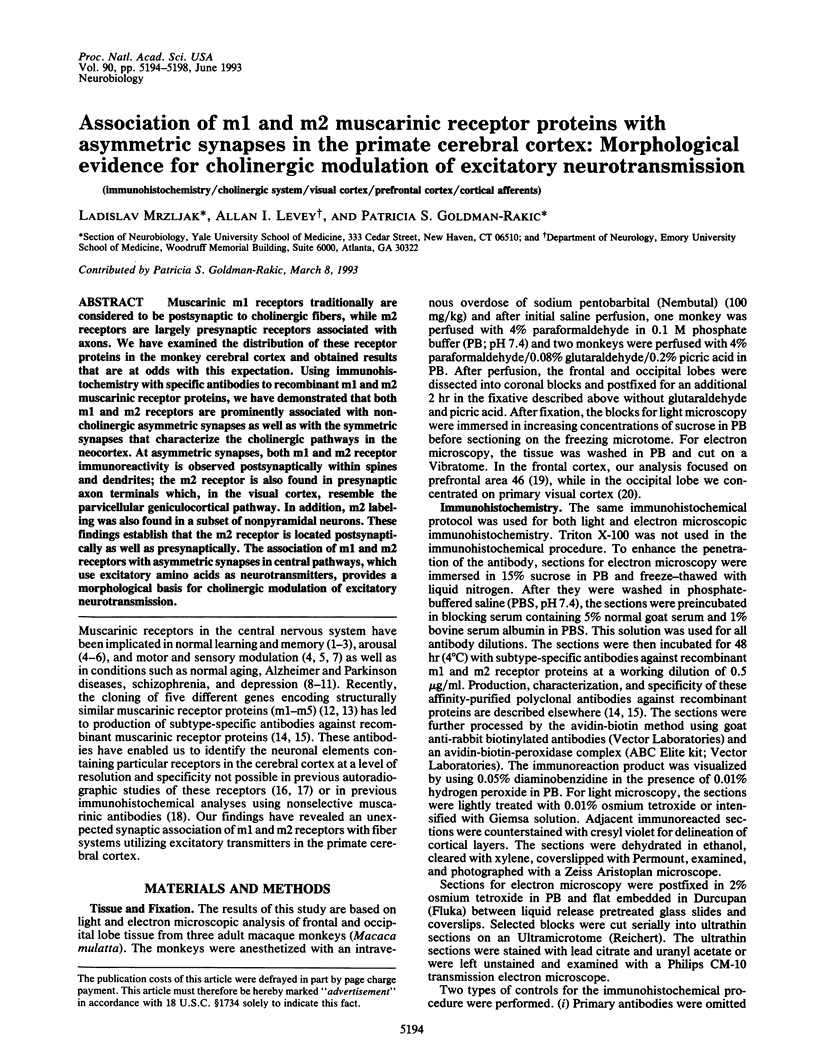
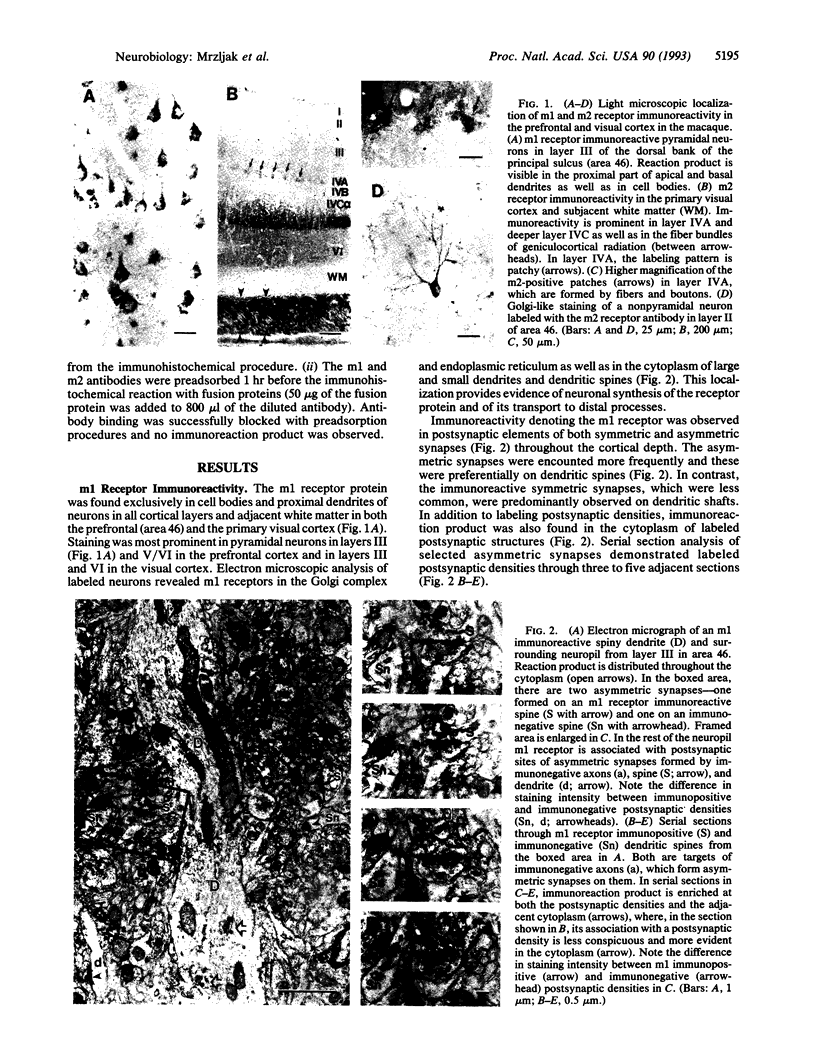
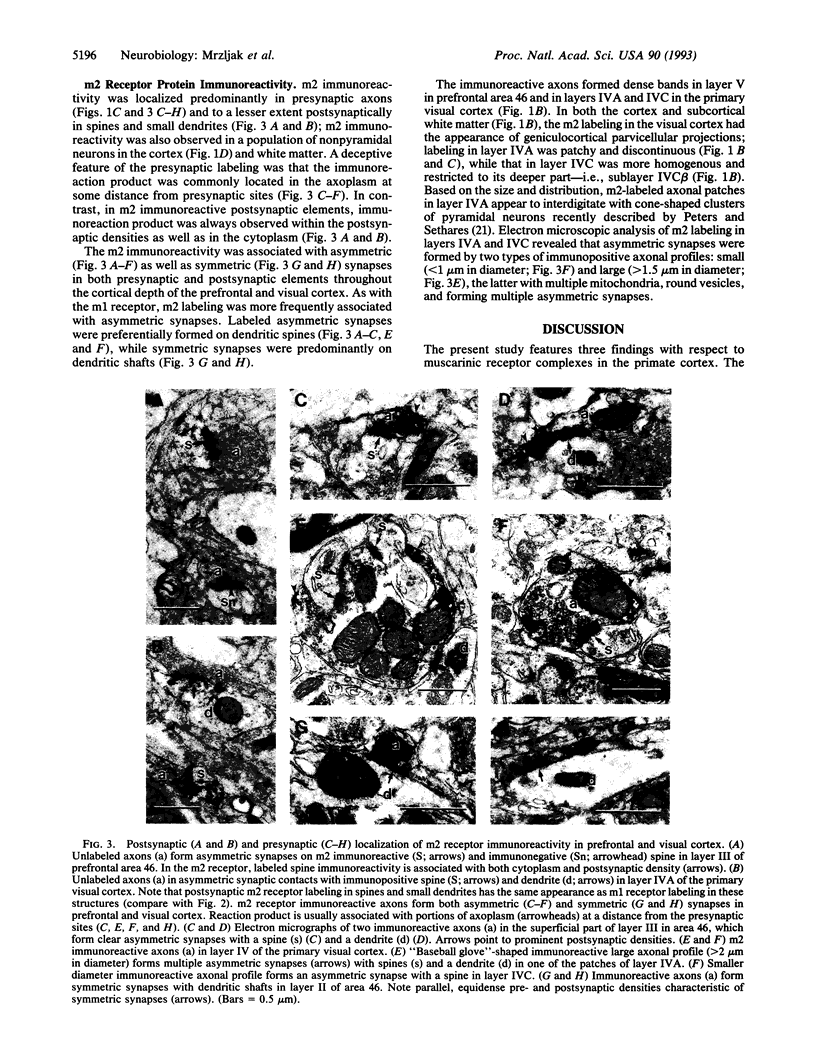
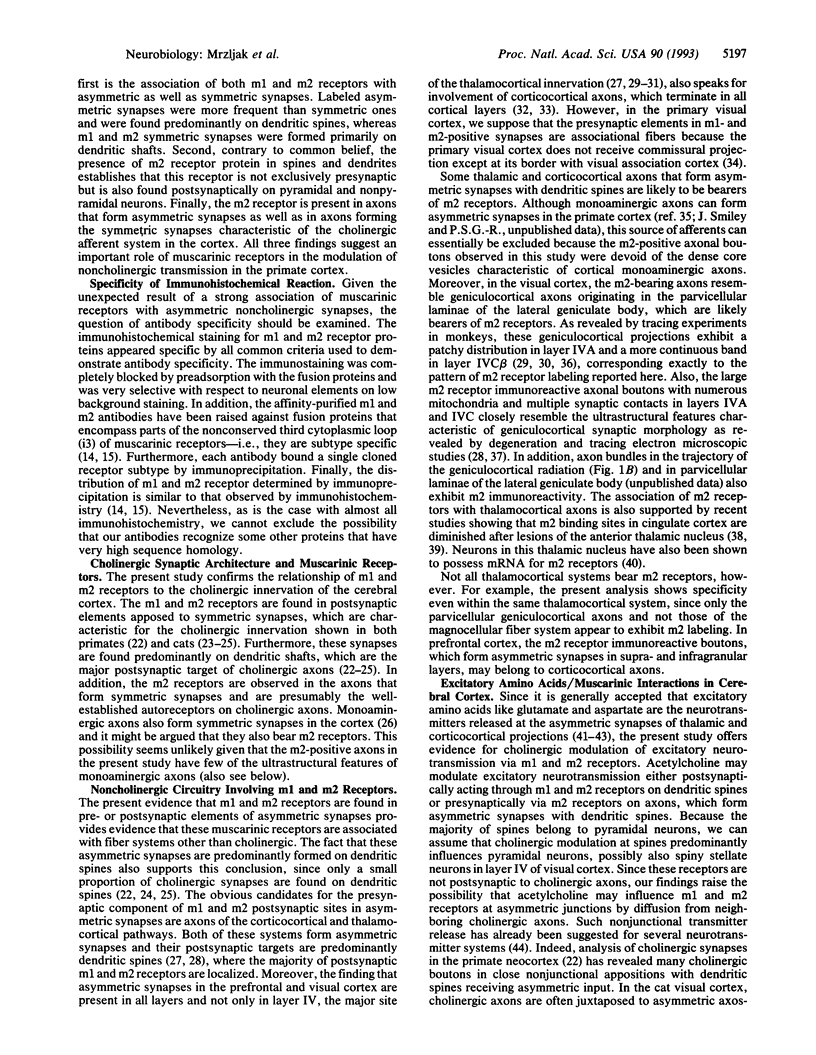
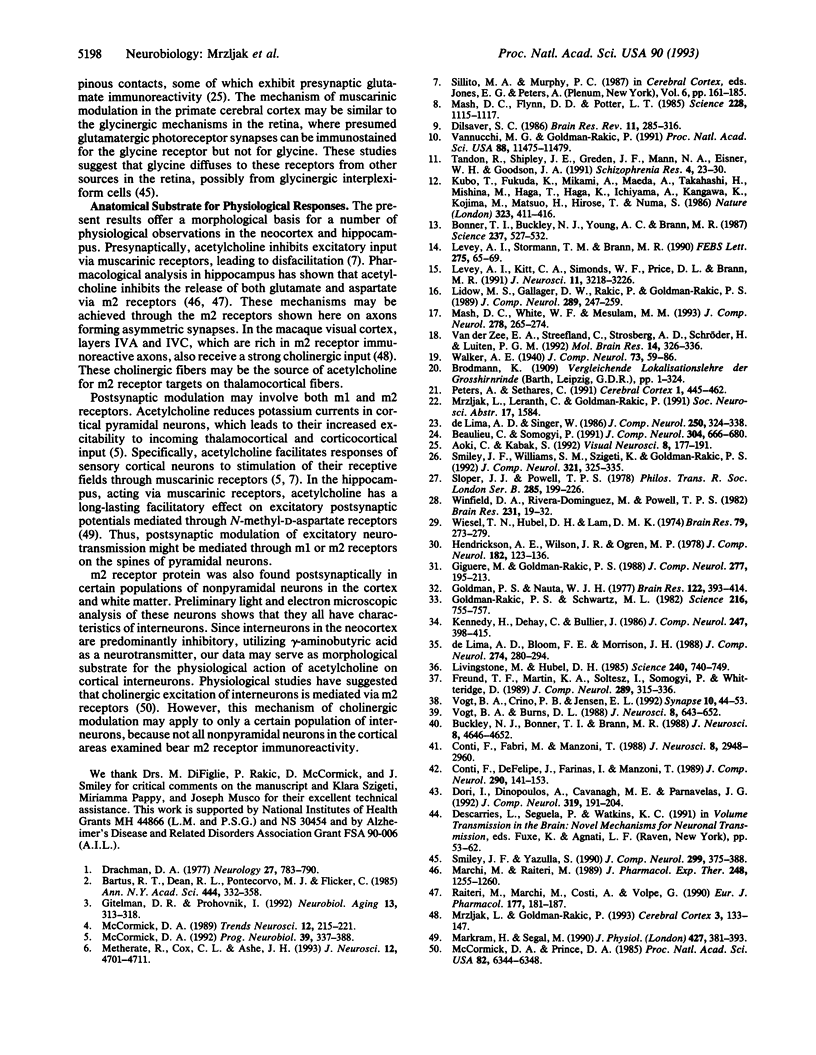
Images in this article
Selected References
These references are in PubMed. This may not be the complete list of references from this article.
- Bartus R. T., Dean R. L., Pontecorvo M. J., Flicker C. The cholinergic hypothesis: a historical overview, current perspective, and future directions. Ann N Y Acad Sci. 1985;444:332–358. doi: 10.1111/j.1749-6632.1985.tb37600.x. [DOI] [PubMed] [Google Scholar]
- Bonner T. I., Buckley N. J., Young A. C., Brann M. R. Identification of a family of muscarinic acetylcholine receptor genes. Science. 1987 Jul 31;237(4814):527–532. doi: 10.1126/science.3037705. [DOI] [PubMed] [Google Scholar]
- Buckley N. J., Bonner T. I., Brann M. R. Localization of a family of muscarinic receptor mRNAs in rat brain. J Neurosci. 1988 Dec;8(12):4646–4652. doi: 10.1523/JNEUROSCI.08-12-04646.1988. [DOI] [PMC free article] [PubMed] [Google Scholar]
- Conti F., DeFelipe J., Farinas I., Manzoni T. Glutamate-positive neurons and axon terminals in cat sensory cortex: a correlative light and electron microscopic study. J Comp Neurol. 1989 Dec 1;290(1):141–153. doi: 10.1002/cne.902900109. [DOI] [PubMed] [Google Scholar]
- Conti F., Fabri M., Manzoni T. Glutamate-positive corticocortical neurons in the somatic sensory areas I and II of cats. J Neurosci. 1988 Aug;8(8):2948–2960. doi: 10.1523/JNEUROSCI.08-08-02948.1988. [DOI] [PMC free article] [PubMed] [Google Scholar]
- De Lima A. D., Singer W. Cholinergic innervation of the cat striate cortex: a choline acetyltransferase immunocytochemical analysis. J Comp Neurol. 1986 Aug 15;250(3):324–338. doi: 10.1002/cne.902500306. [DOI] [PubMed] [Google Scholar]
- Dilsaver S. C. Cholinergic mechanisms in depression. Brain Res. 1986 Sep;396(3):285–316. doi: 10.1016/0165-0173(86)90016-0. [DOI] [PubMed] [Google Scholar]
- Dori I., Dinopoulos A., Cavanagh M. E., Parnavelas J. G. Proportion of glutamate- and aspartate-immunoreactive neurons in the efferent pathways of the rat visual cortex varies according to the target. J Comp Neurol. 1992 May 8;319(2):191–204. doi: 10.1002/cne.903190202. [DOI] [PubMed] [Google Scholar]
- Drachman D. A. Memory and cognitive function in man: does the cholinergic system have a specific role? Neurology. 1977 Aug;27(8):783–790. doi: 10.1212/wnl.27.8.783. [DOI] [PubMed] [Google Scholar]
- Freund T. F., Martin K. A., Soltesz I., Somogyi P., Whitteridge D. Arborisation pattern and postsynaptic targets of physiologically identified thalamocortical afferents in striate cortex of the macaque monkey. J Comp Neurol. 1989 Nov 8;289(2):315–336. doi: 10.1002/cne.902890211. [DOI] [PubMed] [Google Scholar]
- Giguere M., Goldman-Rakic P. S. Mediodorsal nucleus: areal, laminar, and tangential distribution of afferents and efferents in the frontal lobe of rhesus monkeys. J Comp Neurol. 1988 Nov 8;277(2):195–213. doi: 10.1002/cne.902770204. [DOI] [PubMed] [Google Scholar]
- Gitelman D. R., Prohovnik I. Muscarinic and nicotinic contributions to cognitive function and cortical blood flow. Neurobiol Aging. 1992 Mar-Apr;13(2):313–318. doi: 10.1016/0197-4580(92)90044-x. [DOI] [PubMed] [Google Scholar]
- Goldman-Rakic P. S., Schwartz M. L. Interdigitation of contralateral and ipsilateral columnar projections to frontal association cortex in primates. Science. 1982 May 14;216(4547):755–757. doi: 10.1126/science.6177037. [DOI] [PubMed] [Google Scholar]
- Hendrickson A. E., Wilson J. R., Ogren M. P. The neuroanatomical organization of pathways between the dorsal lateral geniculate nucleus and visual cortex in Old World and New World primates. J Comp Neurol. 1978 Nov 1;182(1):123–136. doi: 10.1002/cne.901820108. [DOI] [PubMed] [Google Scholar]
- Kennedy H., Dehay C., Bullier J. Organization of the callosal connections of visual areas V1 and V2 in the macaque monkey. J Comp Neurol. 1986 May 15;247(3):398–415. doi: 10.1002/cne.902470309. [DOI] [PubMed] [Google Scholar]
- Kubo T., Fukuda K., Mikami A., Maeda A., Takahashi H., Mishina M., Haga T., Haga K., Ichiyama A., Kangawa K. Cloning, sequencing and expression of complementary DNA encoding the muscarinic acetylcholine receptor. Nature. 1986 Oct 2;323(6087):411–416. doi: 10.1038/323411a0. [DOI] [PubMed] [Google Scholar]
- Levey A. I., Kitt C. A., Simonds W. F., Price D. L., Brann M. R. Identification and localization of muscarinic acetylcholine receptor proteins in brain with subtype-specific antibodies. J Neurosci. 1991 Oct;11(10):3218–3226. doi: 10.1523/JNEUROSCI.11-10-03218.1991. [DOI] [PMC free article] [PubMed] [Google Scholar]
- Levey A. I., Stormann T. M., Brann M. R. Bacterial expression of human muscarinic receptor fusion proteins and generation of subtype-specific antisera. FEBS Lett. 1990 Nov 26;275(1-2):65–69. doi: 10.1016/0014-5793(90)81440-y. [DOI] [PubMed] [Google Scholar]
- Lidow M. S., Gallager D. W., Rakic P., Goldman-Rakic P. S. Regional differences in the distribution of muscarinic cholinergic receptors in the macaque cerebral cortex. J Comp Neurol. 1989 Nov 8;289(2):247–259. doi: 10.1002/cne.902890206. [DOI] [PubMed] [Google Scholar]
- Livingstone M., Hubel D. Segregation of form, color, movement, and depth: anatomy, physiology, and perception. Science. 1988 May 6;240(4853):740–749. doi: 10.1126/science.3283936. [DOI] [PubMed] [Google Scholar]
- Marchi M., Raiteri M. Interaction acetylcholine-glutamate in rat hippocampus: involvement of two subtypes of M-2 muscarinic receptors. J Pharmacol Exp Ther. 1989 Mar;248(3):1255–1260. [PubMed] [Google Scholar]
- Markram H., Segal M. Long-lasting facilitation of excitatory postsynaptic potentials in the rat hippocampus by acetylcholine. J Physiol. 1990 Aug;427:381–393. doi: 10.1113/jphysiol.1990.sp018177. [DOI] [PMC free article] [PubMed] [Google Scholar]
- Mash D. C., Flynn D. D., Potter L. T. Loss of M2 muscarine receptors in the cerebral cortex in Alzheimer's disease and experimental cholinergic denervation. Science. 1985 May 31;228(4703):1115–1117. doi: 10.1126/science.3992249. [DOI] [PubMed] [Google Scholar]
- Mash D. C., White W. F., Mesulam M. M. Distribution of muscarinic receptor subtypes within architectonic subregions of the primate cerebral cortex. J Comp Neurol. 1988 Dec 8;278(2):265–274. doi: 10.1002/cne.902780209. [DOI] [PubMed] [Google Scholar]
- McCormick D. A., Prince D. A. Two types of muscarinic response to acetylcholine in mammalian cortical neurons. Proc Natl Acad Sci U S A. 1985 Sep;82(18):6344–6348. doi: 10.1073/pnas.82.18.6344. [DOI] [PMC free article] [PubMed] [Google Scholar]
- Metherate R., Cox C. L., Ashe J. H. Cellular bases of neocortical activation: modulation of neural oscillations by the nucleus basalis and endogenous acetylcholine. J Neurosci. 1992 Dec;12(12):4701–4711. doi: 10.1523/JNEUROSCI.12-12-04701.1992. [DOI] [PMC free article] [PubMed] [Google Scholar]
- Mrzljak L., Goldman-Rakic P. S. Low-affinity nerve growth factor receptor (p75NGFR)- and choline acetyltransferase (ChAT)-immunoreactive axons in the cerebral cortex and hippocampus of adult macaque monkeys and humans. Cereb Cortex. 1993 Mar-Apr;3(2):133–147. doi: 10.1093/cercor/3.2.133. [DOI] [PubMed] [Google Scholar]
- Peters A., Sethares C. Layer IVA of rhesus monkey primary visual cortex. Cereb Cortex. 1991 Nov-Dec;1(6):445–462. doi: 10.1093/cercor/1.6.445. [DOI] [PubMed] [Google Scholar]
- Raiteri M., Marchi M., Costi A., Volpe G. Endogenous aspartate release in the rat hippocampus is inhibited by M2 'cardiac' muscarinic receptors. Eur J Pharmacol. 1990 Feb 27;177(3):181–187. doi: 10.1016/0014-2999(90)90268-b. [DOI] [PubMed] [Google Scholar]
- Sloper J. J., Powell T. P. An experimental electron microscopic study of afferent connections to the primate motor and somatic sensory cortices. Philos Trans R Soc Lond B Biol Sci. 1979 Mar 23;285(1006):199–226. doi: 10.1098/rstb.1979.0005. [DOI] [PubMed] [Google Scholar]
- Smiley J. F., Williams S. M., Szigeti K., Goldman-Rakic P. S. Light and electron microscopic characterization of dopamine-immunoreactive axons in human cerebral cortex. J Comp Neurol. 1992 Jul 15;321(3):325–335. doi: 10.1002/cne.903210302. [DOI] [PubMed] [Google Scholar]
- Smiley J. F., Yazulla S. Glycinergic contacts in the outer plexiform layer of the Xenopus laevis retina characterized by antibodies to glycine, GABA and glycine receptors. J Comp Neurol. 1990 Sep 15;299(3):375–388. doi: 10.1002/cne.902990309. [DOI] [PubMed] [Google Scholar]
- Tandon R., Shipley J. E., Greden J. F., Mann N. A., Eisner W. H., Goodson J. A. Muscarinic cholinergic hyperactivity in schizophrenia. Relationship to positive and negative symptoms. Schizophr Res. 1991 Jan-Feb;4(1):23–30. doi: 10.1016/0920-9964(91)90006-d. [DOI] [PubMed] [Google Scholar]
- Vannucchi M. G., Goldman-Rakic P. S. Age-dependent decrease in the affinity of muscarinic M1 receptors in neocortex of rhesus monkeys. Proc Natl Acad Sci U S A. 1991 Dec 15;88(24):11475–11479. doi: 10.1073/pnas.88.24.11475. [DOI] [PMC free article] [PubMed] [Google Scholar]
- Vogt B. A., Burns D. L. Experimental localization of muscarinic receptor subtypes to cingulate cortical afferents and neurons. J Neurosci. 1988 Feb;8(2):643–652. doi: 10.1523/JNEUROSCI.08-02-00643.1988. [DOI] [PMC free article] [PubMed] [Google Scholar]
- Vogt B. A., Crino P. B., Jensen E. L. Multiple heteroreceptors on limbic thalamic axons: M2 acetylcholine, serotonin1B, beta 2-adrenoceptors, mu-opioid, and neurotensin. Synapse. 1992 Jan;10(1):44–53. doi: 10.1002/syn.890100107. [DOI] [PubMed] [Google Scholar]
- Wiesel T. N., Hubel D. H., Lam D. M. Autoradiographic demonstration of ocular-dominance columns in the monkey striate cortex by means of transneuronal transport. Brain Res. 1974 Oct 18;79(2):273–279. doi: 10.1016/0006-8993(74)90416-8. [DOI] [PubMed] [Google Scholar]
- Winfield D. A., Rivera-Dominguez M., Powell T. P. The termination of geniculocortical fibres in area 17 of the visual cortex in the macaque monkey. Brain Res. 1982 Jan 7;231(1):19–32. doi: 10.1016/0006-8993(82)90004-x. [DOI] [PubMed] [Google Scholar]
- de Lima A. D., Bloom F. E., Morrison J. H. Synaptic organization of serotonin-immunoreactive fibers in primary visual cortex of the macaque monkey. J Comp Neurol. 1988 Aug 8;274(2):280–294. doi: 10.1002/cne.902740211. [DOI] [PubMed] [Google Scholar]
- van der Zee E. A., Streefland C., Strosberg A. D., Schröder H., Luiten P. G. Visualization of cholinoceptive neurons in the rat neocortex: colocalization of muscarinic and nicotinic acetylcholine receptors. Brain Res Mol Brain Res. 1992 Aug;14(4):326–336. doi: 10.1016/0169-328x(92)90100-p. [DOI] [PubMed] [Google Scholar]





